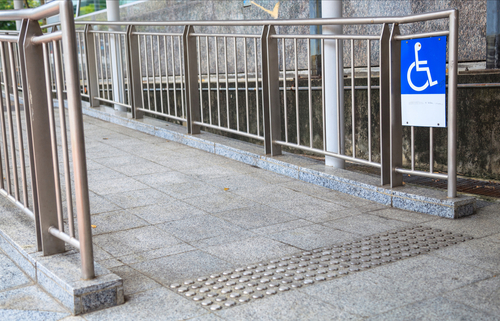Installing an ADA Compliant Ramp

Keeping the doors open isn't just about opening the doors to all customers, it's about establishing and keeping trust with a community. Creating an ADA compliant entrance for your business or business center should look to the functionality beyond the guidelines.
To install an ADA compliant ramp at an entrance, you will want to keep in mind elements such as the materials, the slope, and the aesthetic. Fortunately, guidelines have shifted over the years allowing more materials and styles to compliment locations, especially older, established buildings.
The following tips will help you get your ramps in place quickly and without a need to restart construction or remodeling efforts.
ADA Compliant Ramp Tips
Advances in mobility continue to adjust the expectations of the public complying with regulations now will certainly not inconvenience a business in the future.
Ramp Slope
It's crucial to understand the purpose of an ADA compliant ramp slope. The slope cannot raise more than one inch for every foot of the ramp's length.
This ratio ensures that the climb isn't too strenuous for customers regardless of ability. While a mobility device like a powered scooter can handle a steeper slope, it's best not to put wear on the machinery whenever possible.
A gradual slope takes more space but also provides more comfort and safety. A fall on a shallow slope is far less likely to cause alarm and, as the ramp may be part of your premises, is important for liability.
Hand Rails
The railing is sometimes overlooked in ramp construction. People are keen to think that a ramp itself is enough or only build a railing on one side. Railing on both sides accommodates more people and their chosen style of accessions. Not only that, the parallel railing provides more purchase in an emergency or if inclement weather has marred the ramp.
Handrails don't need to be mounted to the floor or wall, either will do, but they need to be thick enough (1 1/4 inches minimum) to offer resilience against sudden force. They also need to be easy to grip, so no more than 1 1/2 inches in diameter. Make certain, as well, to keep the clearance at least 1 1/2 inches from the wall.
Platforms
Ramps over 30 feet in length create hazards and offer no space to rest or remain neutral. Platforms should be put in every 30 feet at a minimum and be 5 feet by 5 feet to offer a comfortable area to rest on.
This also makes for a place that turning and adjustments can be done without fear of bumping into the railing.
Materials
At one time, aluminum tube railing was the only appropriate material to use. Concrete and steel were the choices for ramps themselves. While the ramp material stays the same, newer guidelines allow for railing materials to match the decor and architectural character.
Wooden railing needs to be secured in smaller intervals than metals to ensure the same tension across a gripping area.
Stability and Mobility
The stability of an ADA compliant ramp is only one goal. For those that need a ramp, it's important that it offers them a safe and reliable pathway.
Remember to account for different weather conditions and keep a ramp clear of debris. For additional information and assistance with your mobility needs, contact BraunAbility.
Related Articles:
- 3 Reasons to Get a Handicap Accessible Van for a Business
- 3 Tips to Choose the Right Handicap Vans
- 3 Tips to Find the Best Accessible Wheelchair Van
- 3 Tips to Find the Right Electric Lift for the Car Owner
- 3 Tips to Make Your Business More Handicap Accessible
- 5 Benefits of Having a Full Size Handicap Van
- 5 Tips on Choosing Wheelchair Lift Support for Vans
- 6 Features to Look for When Buying Handicap Accessible RVs
- 9 Tips on How to Start a Business in Paratransit Services
- Accessible Vehicle: Rear Entry or Side Entry
